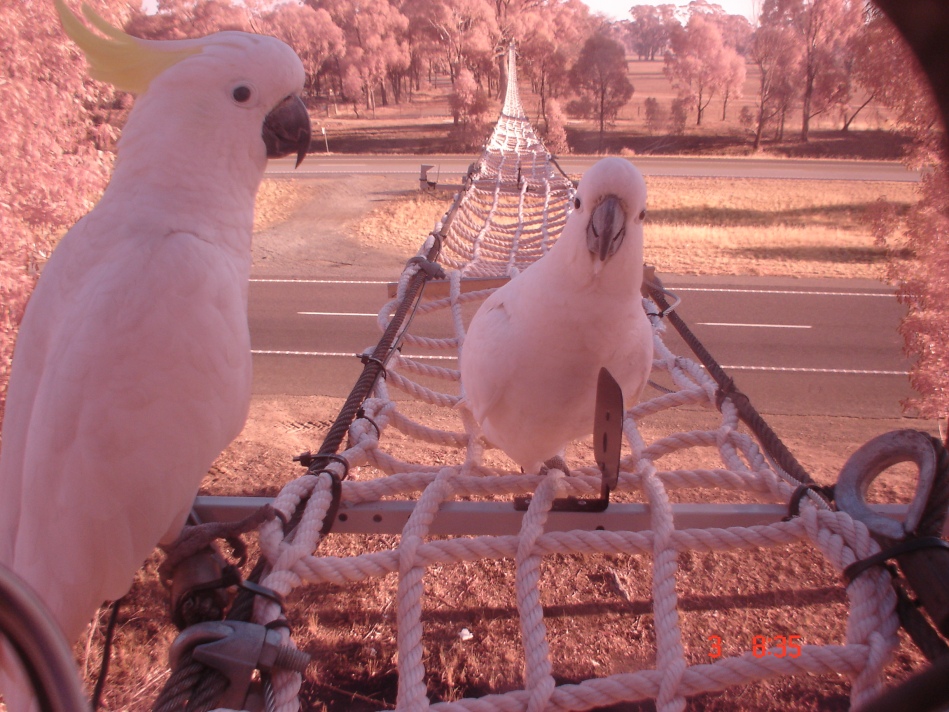I’ve talked a lot about squirrel gliders using the crossing structures on the Hume. But gliders aren’t the only ones exploring new, safer ways of crossing the freeway. Our monitoring cameras have picked up a few other critters I’d like to tell you about.
Firstly, I should mention a bit about the cameras. We now have them installed at canopy bridges and glider poles along the Hume Freeway in Victoria and New South Wales and some have been in place for almost six years. They’re all motion-triggered, so whenever an animal moves past the sensors, we get a photo. Then we sit down and go through all the photos (or videos for the newer cameras) and record what species went across and when. I still remember seeing the first glider cross – it was so exciting! Unfortunately flicking through photos can get a tiny bit tedious, so the 1000th glider was a touch less exciting.

Most of you will be well acquainted with the common brushtail and common ringtail possum. Both are regular visitors at some of our bridges. Now I can already hear groans and mutterings of “I’ve got plenty living in my roof” or “eating my roses”, but hear me out. While city possums might have plenty of houses to live in and gardens to eat, country possums out ‘in the wild’ do it tougher. And I think we can all agree that just because a species is common, doesn’t mean it deserves to be flattened under the wheels of a truck. More importantly, just because something seems common right now, doesn’t mean it can’t easily become rare in the future. It can’t hurt to act before we have a problem.
That’s why I was so thrilled to see our first brush-tailed phascogale crossing a canopy bridge. Granted, that very first photo only captured the animals rear end, but it was a different rear end. A stiff black-bottle brush, as opposed to the long, fluffy rudders I’d been staring at (and counting) for hours at a time. Ferocious little carnivores with unusual breeding patterns, brush-tailed phascogales are a threatened species in Victoria and often only seen in the area as roadkill. We’ve had a handful of crossings at our Longwood canopy bridge which is great news for local populations.

I’ll end this post with the oddballs, the strange and the unexpected. Top of the list is the goanna (or lace monitor) that strolled across one sunny day, much to the disgust of a local magpie. To my horror (irrational fear alert), large hunstman spiders also triggered the cameras every now and then. Microbats, frogs, ducks, parrots, magpies and a host of other birds have also been recorded, although they tend to just hang out on the structures rather than cross the road. And for the ever cantankerous cockatoos, the bridge is nothing more than a large bird-toy. At least they seem to be having fun.

Originally posted at my old site, ksoanesresearch.wordpress.com, May 10, 2013

Pingback: Roads, wildlife and a finished thesis | life. on.the.verge.
Pingback: Other wildlife braving the bridges | Kylie Soanes's Research
Hello there
Just curious as we drive up the Hume today in November 2017, why are so many crossing bridges for creatures without ropes anymore?
Cheers
LikeLike
Hi Attila, Thanks for getting in touch! The crossings without ropes are targeted specifically to the gliding possums. They use these as ‘fake trees’, launching from the top of one and gliding through the air to land on the next (they have a special skin flap between their legs and arms, like a little wing-suit). There are a couple of reasons road agencies might choose poles over bridges. 1) it might be too difficult to build a bridge if the road is raised above ground, or if the bridge might be too long to build safely. 2) poles are much cheaper than bridges, so often it is a cost saving exercise. Personally I like to see structures that can help more than one species, but every step in the right direction is a good one. I hope that answers your question!
LikeLike